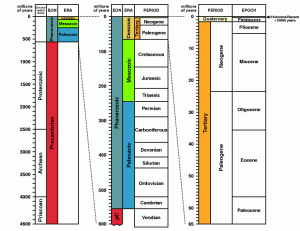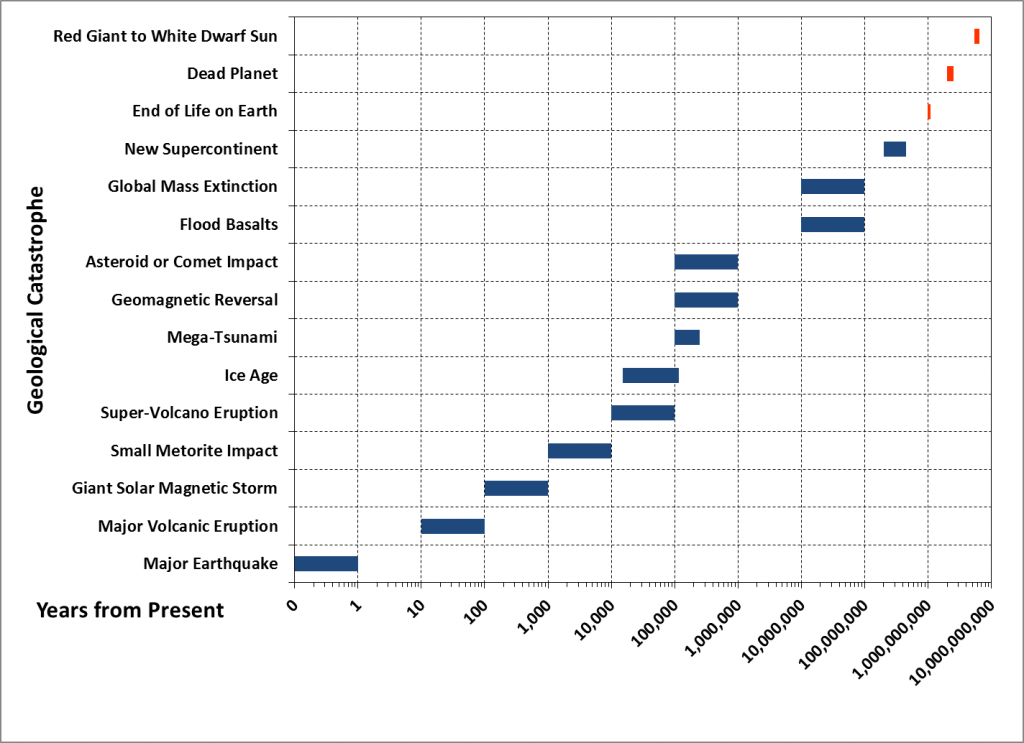
Geological Catastrophes Waiting to Happen or TEOTWAWKI
3rd Stone from the Sun (Jimi Hendrix and Chad Chandler, 1967):
Hendrix: Star fleet to scout ship, please give your position. Over.
Chandler: I am in orbit around the third planet of star known as Sun. Over.
Hendrix: May this be Earth? Over.
Chandler: Positive. It is known to have some form of intelligent species. Over.
Hendrix: I think we should take a look.
Throughout its 4.5 billion year history, the geology of the Earth has created an environment that allows life to thrive or causes it to die.
As a prerequisite to this musing, I urge you to study the Geologic Time Scale posted below. In particular, note the expansion of the vertical scale from left to right and the Holocene Epoch (Recent) beginning 10,000 years ago. The Holocene marks the beginnings of modern man and the spread of human civilizations. Our presence on Earth is merely an instant in geological time.
For those interested, I explored the concept of geological time in a previous musing called “The Fourth Dimension” (Mercenary Musing, April 28, 2008).
The Geological Time Scale
(Courtesy of Andrew McRae, University of Calgary).
That’s the past; now for the future.
I have compiled a list of geological catastrophes that will radically affect future Earth environments until the times when life ceases to exist, the Earth becomes a dead planet, and the Sun dies. I have assigned each event a rough order of magnitude time frame within which it has nearly a 100% probability of happening.
The logarithmic chart below plots 15 geological catastrophes with estimated time ranges for 100% probability of occurrence. Note that for some long-lasting events whose commencement is well-determined, I have plotted the duration:
Within 100 = One Year: Major Earthquakes.
Earthquakes > 7.0 magnitude occur about 15 times per year (USGS). They cause widespread and catastrophic structural damage, may result in significant loss of life, and may generate deadly tsunamis if the epicenter is located offshore or near a coast. Epicenters are mostly along the plate boundaries of the Ring of Fire that circumscribes the Pacific Ocean, but they also include SW Asia, the Himalayas of India and China, and the Caribbean. Giant earthquakes have caused nearly 900,000 deaths since 1990.
Within 101 – 102 = 10 to 100 Years: Major Volcanic Eruption.
There are 1500 active volcanoes in the world and about 50 of them erupt per year. Very large volcanic eruptions can result in significant loss of life, human displacement, temporary climate cooling, famine, and disruption of air travel.
Major eruptions over the past 250 years include Laki, Iceland (1783-84), Vesuvius, Italy (15 eruptions), Tambora, Sumatra (1815), Krakatau, Java-Sumatra (1883), and Pinatubo, Philippines (1991). Tambora blasted so much volcanic ash and noxious gas into the upper atmosphere that it lowered temperatures about -1C and resulted in the “Year Without a Summer” in 1816. There were severe floods, famines, and epidemics in Europe, North America, China, and India.
Within 102 – 103 = 100 to 1000 Years: Giant Solar Magnetic Storm.
Solar magnetic storms are a common phenomenon; solar super storms occur about every 500 years with severe events once a century. Radiation and high-energy particles produced by a solar super storm will cause massive power outages and disrupt or destroy worldwide communications systems including satellites, GPS, electrical devices, and radio, television, wireless, and telephone networks.
The last solar super storm in1859 caused telegraph communications to fail worldwide and gave their operators electrical shocks. The resulting aurora was visible as far away as the subtropics of the Americas. Economic costs of an equivalent storm today have been estimated at $2.6 trillion. A much smaller storm in 1989 caused temporary loss of electrical power over most of Quebec.
Within 103 – 104 = 1000 to 10,000 Years: Small Meteorite Impact.
Meteorites with a diameter of more than 50 meters strike Earth on average every 1000 years. They will generally explode in the lower atmosphere and can cause massive destruction over thousands of square kilometers and significant loss of life if over a populated area. The 1908 Tanguska event in Siberia is the largest recent occurrence.
Within 104 – 105 = 10,000 to 100,000 Years: Super-Volcano Eruption; Ice Age.
Super-volcanos are located over mantle hotspots and produce eruptions of an apocalyptic magnitude. They cause immediate and massive landscape destruction and catastrophic loss of plant and animal life due to ash flows, ash falls, noxious gases, landslides, and floods. Long-term effects are volcanic winters and severe climate changes resulting in mass extinctions.
The last three super-volcanic eruptions occurred at Taupo, New Zealand, 26,500 and 254,000 years ago, and Mt. Toba, Sumatra, about 74,000 years ago. The Toba event likely caused a bottleneck in human evolution and initiated the last Ice Age.
The largest know super-volcano is Yellowstone, Wyoming, which had four mega-eruptions and another three giant eruptions in the past six million years. The most recent major Yellowstone Caldera eruption was 174,000 years ago and a mega-eruption last occurred 640,000 years ago. Yellowstone is long overdue for another event. However, the magnitude of its next eruption is not predictable.
Ice ages are rare in Earth’s geological history. However, the Quaternary is a 2.6 million year period characterized by multiple, continental-scale ice advances (glacials) and retreats (interglacials). These cycles generally last from 40,000 to 100,000 years.
The ice ages were initially spawned by massive volcanic eruptions in Central America that created a land bridge (Isthmus of Panama) which separated the Atlantic and Pacific Oceans, drastically altered ocean currents, and resulted in rapid cooling of the Earth. The Quaternary is also the time when our first hominid ancestors appeared.
The last ice age started to wane 10,000 years ago and coincided with the emergence of modern man and spread of human civilizations. Continental ice sheets still cover about 10% of the world’s surface in Greenland and Antarctica. The next ice advance is predicted to commence in about 15,000 years and could last from 25,000 to 85,000 years.
Within 105 – 106 = 100,000 Years to 1,000,000 Years: Mega-Tsunami; Geomagnetic Reversal; Asteroid or Comet Impact.
A mega-tsunami is caused by a massive landslide or impact event with waves 100-300 meters high and is most likely to occur around volcanic islands. A mega-tsunami will inundate coastlines over significant parts of the Earth causing immeasurable destruction of infrastructure and massive loss of life.
The Hawaiian Island chain has had 70 major landslides and mega-tsunamis over the past 20 million years giving a periodicity of about 250,000-300,000 years. Landslides associated with tectonic and volcanic activity in the Canary and Cape Verde Islands in the eastern Atlantic also have a high likelihood of generating widespread mega-tsunamis.
A geomagnetic reversal is a change in the Earth’s magnetic field wherein the positions of magnetic north and magnetic south are interchanged. There is no recognized periodicity for reversals. Most occurrences range from 100,000 to 1 million years, and the average is once every 450,000 years. There have been six reversals in Quaternary time with the last major reversal 780,000 years ago. A very brief reversal happened 41,000 years ago.
A magnetic reversal will wreak havoc on navigation and communication devices. Because the Earth’s magnetic field will weaken drastically and give little protection from cosmic rays and the solar wind, the 1000- to 10,000-year reversal process could also result in significant extinctions.
There are over 7000 known near-Earth asteroids of which 500-1000 have diameters greater than 1 kilometer. There are 85 known near-Earth comets.
Asteroids > 1 kilometer strike earth on
average every 500,000 years while those with 5 kilometer diameters occur about every 20 million years. The last known meteorite larger than 10 kilometers impacted the Gulf of Mexico near the Yucatan Peninsula of Mexico 66 million years ago and triggered the Cretaceous-Paleogene mass extinction, including the end of the dinosaurs.
Within 107 – 108 = 10,000,000 to 100,000,000 years: Flood Basalts; Global Mass Extinction.
Flood basalts are igneous provinces that cover thousands of square kilometers and erupt over a mantle hotspot for a few million years. Examples include the Colombia Plateau of Idaho, Oregon, and Washington, Ongong Plateau of Java, Dekkan Traps of India, and Siberian Traps of Russia. These voluminous lavas release immense amounts of noxious gases and cause extreme climate change and may result in mass extinctions.
Eruptions of the Siberian basalts are responsible for the Permian-Triassic extinction of species 250 million years ago, while the Dekkan basalts likely contributed to the Cretaceous-Paleocene extinction at 66 million years.
Geologists have proposed that the Iceland volcanic field is an incipient flood basalt province. Iceland is unique and is particularly dangerous. Because of its location on the Mid-Atlantic Ridge, an oceanic spreading center that also overlie a mantle hotspot, the potential for gigantic eruptions is greatly enhanced.
Global mass extinctions have occurred five times since the end of Cambrian time 500 million years ago, giving an average periodicity of 100 million years. There have also been many smaller extinction events in the geological record since the end of Precambrian time.
Mass extinctions with the percentage of all species that disappeared include: Ordovician-Silurian (85%); late Devonian (75%); Permian-Triassic (96%); Triassic-Jurassic (50%); and Cretaceous-Tertiary (65%). Extinctions have been correlated with impact events, flood basalt eruptions, and abrupt climate changes. Catastrophic methane release from the oceans has also been proposed as a mechanism for past and future mass extinctions.
Within 108 -109 = 100,000,000 to 1,000,000,000 Years: New Supercontinent.
Geologists hypothesize that a new supercontinent, christened Pangaea Ultima, will form in the next 200 to 250 million years. The American, European, and African continents will converge and collide, starting with the disappearance of the Mediterranean Sea followed by consumption of the Atlantic Ocean. Australia will be joined to Antarctica.
As the supercontinent is constructed, there will be wide and wild fluctuations of atmospheric oxygen and temperatures resulting in mass extinctions.
109 – 6.5 x 109 = 1 billion years to 6.5 billion years: End of Life on Earth; Dead Planet; Red Giant to White Dwarf Sun.
Geological evidence indicates that life forms will remain viable on the Earth for the next 1.0 to 1.1 billion years. As our mature Sun grows hotter, the Earth will warm significantly, water will evaporate, and being unable to freeze in the upper atmosphere, will escape into space leaving the planet without surface water and therefore, without life.
Between 2.0 to 2.5 billion years into the future, the radioactive fuel in Earth’s interior will run out, and the decay processes that provide its geothermal heat will dissipate. Without mantle currents, crustal plate tectonic movements will cease and Earth will lose its magnetic field and its atmosphere. The planet will become a dry, cold, barren desert.
At this stage, Earth will resemble present-day Mars, which once had a significant magnetic field, a dense atmosphere, abundant surface water, and active tectonic and volcanic processes, all of which are now extant.
In 5.4 billion years, the 10 billion-year old Sun will have fused all the hydrogen in its core into helium atoms and will begin to morph into a red giant star.
The Sun will grow so large during the next billion years that it will cannibalize the inner planets, including Earth. Finally it will burn itself out and become a white dwarf at the ripe old age of 11.2 billion years.
And that’s all, folks. It’s the End of the World as We Know It (REM, 1987).
But as a geologist, a Cornucopian, and an optimist, I trust that mankind will have migrated to another blue planet long before most of these catastrophic geological events will occur.
Ciao for now,
MORE or "INDUSTRY ANALYSTS"
Mickey Fulp - Mercenary Alert: Is Zinc Still a Four-Letter Word?
Read the Report Here Mercenary Alert: Is Zinc Still a Four-Letter Word? ... READ MORE
Top 10 Financings of May 2017
May saw 125 financings close in the Canadian financial markets for C$366.5 million including 64 fina... READ MORE
ORENINC INDEX jumps as gold gets political again
ORENINC INDEX – Monday, June 12, 2017 North America’s leading junior mining finance data provide... READ MORE
The Week of June 5th to June 11th, 2017 "A Brief Look Back Into Tomorrow"
The new North American trading week began on Monday June 5th with... READ MORE
The Week of May 29th to June 4th, 2017 "A Brief Look Back Into Tomorrow"
The new North American trading week began on Monday, May 29th wit... READ MORE













